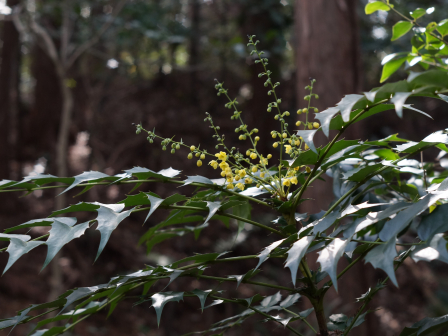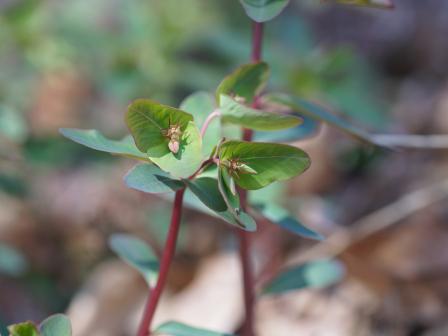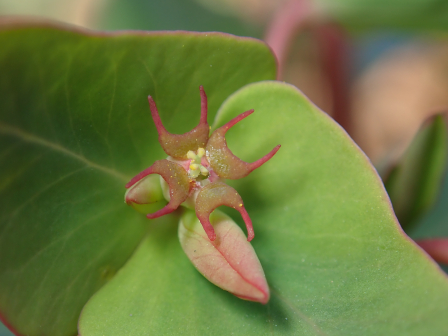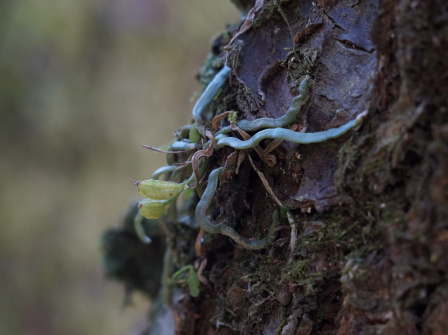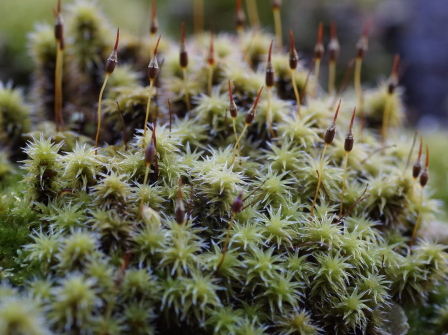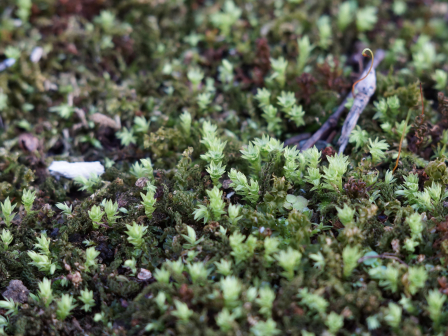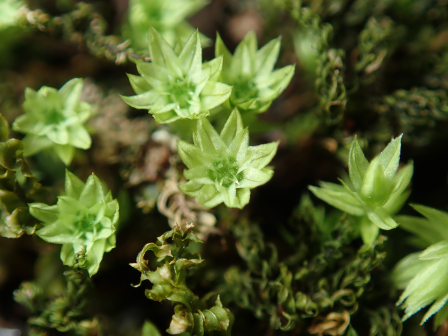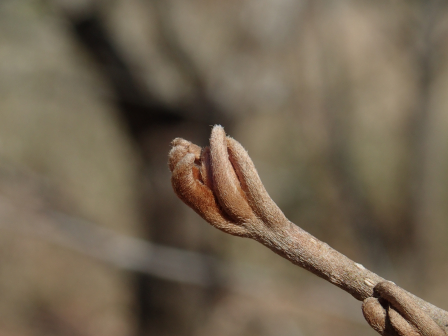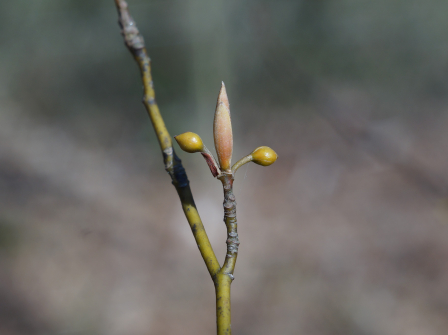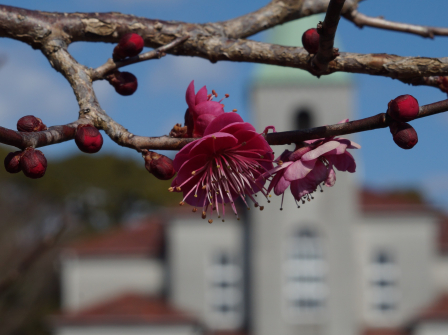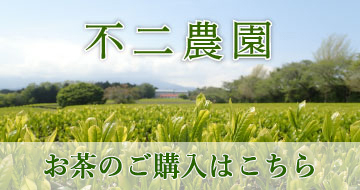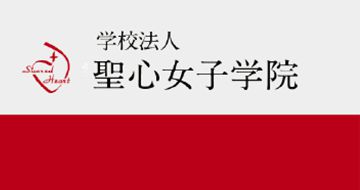フィールド日記
2023.03.10
ヒイラギナンテン
林内でヒイラギナンテンが咲いています。学名をBerberis japonicaといい、「日本の」を意味する種小名をもっていますが、ヒマラヤから台湾、中国が原産で日本には17世紀に渡来したといわれています。庭や公園などによく植栽されますが、逸出したものが林内でも見られます。
"Hiiragi-Nanten (ヒイラギナンテン)" trees are in bloom in forests. Although their scientific name is "Mahonia japonica" and their species name "japonica" means "Japanese", they originally grew spreading from the Himalaya region to Taiwan and China and came to Japan in the 17th century. "Hiiragi-Nanten" trees are often planted in gardens and parks, but you can see the trees that have escaped into forests.
2023.03.07
ナツトウダイ
クヌギ林でナツトウダイが咲いています。名前にナツがつきますが、花は春に咲きます。
花には先のとがった三日月形の腺体が4個ついており、蜜を分泌しています。
The "Natsu-Toudai (ナツトウダイ)" plants are in bloom in the Japanese chestnut oak woodland. The name has "Natsu (ナツ)", which means "summer", but they bloom in spring. The flowers have four crescent-pointed glands, producing nectar.
2023.03.03
クモラン
梅の木に着生しているクモランが果実をつけています。クモランは葉をもっておらず、代わりに葉緑体をもった根が放射状に広がり、光合成をしています。このユニークな姿を蜘蛛に見立ててクモランと呼ばれています。花は初夏に咲きますが、果実は翌春に熟します。写真のクモランも、まもなく果実が開き、ほこりのような細かい種子を飛ばすと思われます。
The "Kumo-Ran (クモラン)" orchids growing on a plum tree are bearing their fruit. They have no leaves, so they photosynthesize with their roots having chloroplasts that spread out radially. The name comes from the fact that people view the shape of its roots as a spider. They bloom in early summer and bear fruit in the following spring. The fruit of the "Kumo-Ran" in the photo will probably ripen and spread its seeds soon.
2023.02.28
エゾスナゴケ
エゾスナゴケが胞子体を伸ばしています。胞子体は赤いとんがり帽子をかぶっているようでユニークです。エゾスナゴケは強い光や乾燥に強く、都市部でも見られる身近なコケですが、湿ると写真のように淡い緑色の葉が星形に開いてきれいです。
The "Ezo-Sunagoke (エゾスナゴケ)" mosses are growing their sporophytes. Their sporophytes are unique because they look as if they were wearing a red pointy hat. The "Ezo-Sunagoke" mosses are resistant to strong sunlight and dryness, so they are common even in urban areas. When they get wet, they open their light green leaves in the shape of star. They are beautiful.
2023.02.24
コバノチョウチンゴケ
中学校舎の中庭で、コバノチョウチンゴケが新芽を出しています。早春に出る新芽はとても鮮やかな緑色できれいです。
2枚目の写真は、造精器があつまっている部分で、雄花盤(ゆうかばん)と呼ばれ、花のように見えます。
The "Kobano-Chouchin-Goke (コバノチョウチンゴケ)" mosses are starting to sprout in the courtyard of the junior high school building. The sprouts that grow in early spring are very bright green and beautiful. The second photo shows the part where there is antheridium looking like a flower.
2023.02.21
アワブキ
写真は共生の森のアワブキの冬芽です。アワブキの冬芽は裸芽で、小さい葉がむき出しになっています。冬芽は褐色の毛に覆われていて、手袋のようなユニークな形をしています。和名は、生木を火にくべると、切り口から泡をふくことに由来します。
The photo shows a winter bud of an "Awabuki (アワブキ)" tree growing in the "Kyosei-Forest (共生の森)". The bud is categorized as "naked buds", exposing their small leaves. The bud is covered with brown hair and it uniquely looks like a glove. The name comes from the fact that when we put its green wood into the fire, it produces bubbles from its cut.
2023.02.17
コスギゴケ
コスギゴケが胞子体をつけていました。スギゴケのなかまは、体がスギの枝のように見えることが特徴です。コスギゴケは理科の教科書でもコケ植物のセン類の代表として紹介されている植物で、馴染みのあるコケです。
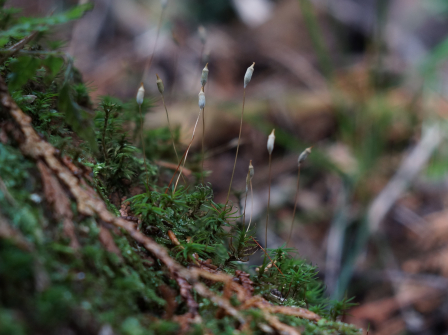
The "Ko-Sugigoke (コスギゴケ)" mosses are bearing their sporophytes. Mosses belonging to the "Sugigoke (スギゴケ)" group have a body that looks like the branches of Japanese cedar trees. The "Ko-Sugigoke" moss is familiar to us because they are introduced in science textbooks as typical of mosses belonging to the Musci group.
2023.02.14
ミノゴケ
写真はカエデの樹皮に着生しているミノゴケの胞子体です。胞子体の先端のふくらみを朔(さく)といい、中に胞子が入っています。和名は、朔が長い毛の生えた帽子状のものをかぶっており、蓑をかぶっているように見えることに由来します。
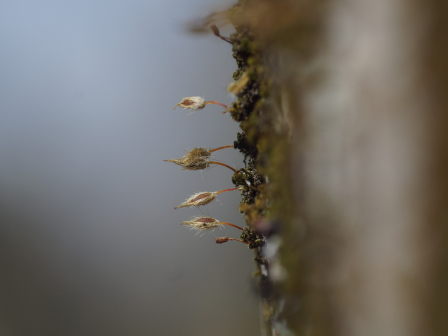
The photo shows the sporophytes of a "Mino-Goke (ミノゴケ)" moss growing on the bark of a maple tree. The swelling tips of the sporophytes are called capsules and have spores inside. The name comes from the fact that their sporophytes have a hairy hat-like thing that looks like a Japanese traditional raincoat "Mino (蓑)".
2023.02.10
クロモジ
写真はクロモジの冬芽です。中心にある細長い冬芽が葉芽で、左右の丸い冬芽が花芽です。クロモジは葉や枝を傷つけるとよい香りがし、つまようじの原料として利用されています。
The photo shows the winter buds of a "Kuromoji (クロモジ)" tree. The slender bud on the center is a leaf bud and the rounded buds on the both sides are flower buds. Scratching their leaves or branches, they smell uniquely good. Scratching their leaves or branches, they smell uniquely good. They are used for making toothpicks.
2023.02.07
コウバイ
築山のコウバイ(紅梅)が咲いています。ウメにはたくさんの園芸品種があり、花の色や花弁の枚数、咲く時期などさまざまです。これは薩摩紅梅という品種で、不二聖心では一番早く咲き始めます。
A red plum tree is in bloom on the artificial hill. "Ume (ウメ)" trees have many cultivated varieties. Each variety is different in color, the number of petals and when to bloom. This one is called "Satsuma-Koubai (薩摩紅梅)", and it starts to bloom earliest on campus.


